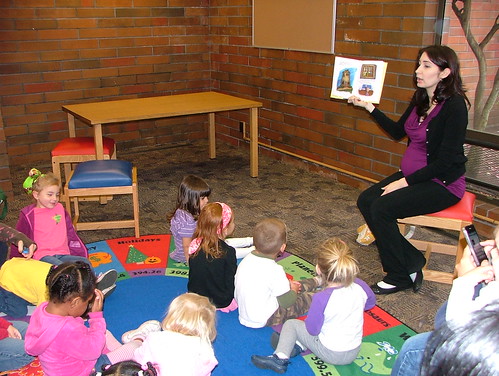(I promise all posts won't be this long!)
(CC image, courtesy of JBLM MWR Marketing on Flickr)
Quiet.
Be
quiet! Pay attention. Stop fidgeting! Sit still.
How many times do you think children
hear those words, or some version of them, every day? So many. Sooooo
many. At school, at the library, restaurants, grocery stores (and on,
and on). Even, to a lesser extent, at home.
Being quiet is hard work! So is being
and quiet and having to pay
attention. Being quiet, paying attention, and being told to be
still is even harder. Can you do it? For how long? Be
honest...are you really being still? Next
time you are in a presentation/staff meeting/conference/lecture, etc.
notice your hands. Clicking a pen? Doodling? Flipping through your
handout? What about your feet? Swinging your legs? Tapping your toes?
Do you get up and stretch or walk around? How much of the time were
you actually still,
staring straight ahead, hands in your lap, and looking at the
speaker?
When I
first started working, one of my coworkers presented an inservice
about this very topic. As she spoke, she asked people to share what
they were doing while they were listening to the presentation. Off
the top of my head, I remember people were doodling, chewing their
lip, sitting on their hands and swinging their legs, chewing their
pen caps, and rolling their head from side to side. I was drawing
circles in my notebook.
But, can this translate to kids? Can kids really pay attention while continuing to move? Yes! It seems counterintuitive, for sure. Sydney Zentall, Ph.D, a professor at Purdue University who studies the relationship between impulse control in students with ADHD with increased stimulation (click here for a list of her publications), was quoted by ADDitude.com as saying that an activity that uses a sense other than that required for the primary task--listening to music while reading a social studies textbook--can enhance performance in children with ADHD (quote source).
I have seen this evidenced in my own son. He will be engrossed in pushing a truck across the kitchen, seemingly in his own world, yet pipe right in to my conversation with my husband. Other times, when we specifically ask him to be quiet and listen, I can almost see his mind wandering off (probably to WALL-E, his current obsession) :)
So, how can you incorporate movement into listening in your speech room, classroom, or even home?
(CC image, courtesy of gernhaex on Flickr)
- Allow fine motor movement. In our preschool, we put together “busy bags” to use during times when kids needed to sit and listen (e.g., circle time, story time). Kids could pick from a bag that contained small items such as a small stuffed animal, a squishy ball, playdoh, a bean bag, etc. Textures are great—something for kids to run their hands over, turn in their hands, squeeze. Think about how we as adults play with our pens! This is translating that into a kid friendly item. You could utilize these during individual or small group therapy sessions as well as when you are in the classroom.
- Allow gross motor movement. I realize you don't want kids running in circles around your classroom as you read Brown Bear, Brown Bear or conduct a language therapy session, but there are ways to provide controlled gross motor movement without proving to be a distraction. If you have access to a physical therapist in your work environment, they are a great resource in this area. From my personal experience, products such as wiggle seats
, resistance bands, and even simply standing vs. sitting can work. (Or, should you have a limitless budget--hahaha!--check these stand-up desks out!)
- Complete a gross motor activity before beginning your lessons or an activity where paying attention is going to be important. Run laps around the playground at recess, do jumping jacks by your desk, try some yoga moves. When you come back to the classroom or take a seat, allow some stretching. Or, try taking a walk while doing therapy: jump onto artic words, walk and find items from a science vocabulary list, etc.
Keep in mind that these are meant to be sensory stimulation inputs, not distractions to others (i.e., stick to squishy balls not flashing lights or beeping toys). Not every student will benefit from additional stimulation, but some might! Keep these tools in your therapy toolbox and try them when you see a student struggling to "sit still"! (p.s. share them with classroom teachers, too!)
Resources:
Fidget to Focus: How Our Sensory System Impacts ADHD and Executive Functions (Powerpoint presentation) by Roland Rotz, Ph.D.
Zentall, Sydney S., & Zentall, T.R. (1983). Optimal Stimulation: A Model of Disordered Activity and Performance in Normal and Deviant Children. Psychological Bulletin, 94, 446-471.
Fidget to Focus: Outwit Your Boredom: Sensory Strategies for Living with ADD by Roland Rotz, Ph.D and Sarah D. Wright, M.S., A.C.T.
by Roland Rotz, Ph.D and Sarah D. Wright, M.S., A.C.T.
- Although this book is written as a guide for children and adults with ADD., the idea of using movement to assist in focus can be adapted to all learners. From a review of the book, "Advocating repetitive sensory-motor activities as a fundamental strategy for improving attention and other cognitive abilities, they present a unique and fun way to turn outer chaos into calm," Patricia O. Quinn, MD, Director, National Center for Gender Issues and ADHD


